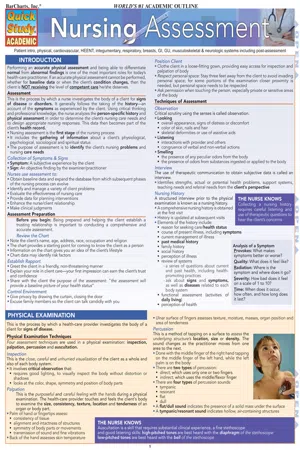
- 44 pages
- English
- ePUB (mobile friendly)
- Available on iOS & Android
eBook - ePub
About this book
Our 3-panel (6-page) guide—jam-packed with information—provides a detailed review of a key aspect of the nursing profession: assessment. A perfect resource for nursing students or those already in the field who want to brush up on their skills, this guide covers the key concepts, skills and techniques essential to effective nursing assessment. Each section features "The Nurse Knows" summary of critical points, set off graphically for easy reference. Tables and images further enhance the text.
Frequently asked questions
Yes, you can cancel anytime from the Subscription tab in your account settings on the Perlego website. Your subscription will stay active until the end of your current billing period. Learn how to cancel your subscription.
At the moment all of our mobile-responsive ePub books are available to download via the app. Most of our PDFs are also available to download and we're working on making the final remaining ones downloadable now. Learn more here.
Perlego offers two plans: Essential and Complete
- Essential is ideal for learners and professionals who enjoy exploring a wide range of subjects. Access the Essential Library with 800,000+ trusted titles and best-sellers across business, personal growth, and the humanities. Includes unlimited reading time and Standard Read Aloud voice.
- Complete: Perfect for advanced learners and researchers needing full, unrestricted access. Unlock 1.4M+ books across hundreds of subjects, including academic and specialized titles. The Complete Plan also includes advanced features like Premium Read Aloud and Research Assistant.
We are an online textbook subscription service, where you can get access to an entire online library for less than the price of a single book per month. With over 1 million books across 1000+ topics, we’ve got you covered! Learn more here.
Look out for the read-aloud symbol on your next book to see if you can listen to it. The read-aloud tool reads text aloud for you, highlighting the text as it is being read. You can pause it, speed it up and slow it down. Learn more here.
Yes! You can use the Perlego app on both iOS or Android devices to read anytime, anywhere — even offline. Perfect for commutes or when you’re on the go.
Please note we cannot support devices running on iOS 13 and Android 7 or earlier. Learn more about using the app.
Please note we cannot support devices running on iOS 13 and Android 7 or earlier. Learn more about using the app.
Yes, you can access Nursing: Assessment by in PDF and/or ePUB format, as well as other popular books in Medicine & Medical Theory, Practice & Reference. We have over one million books available in our catalogue for you to explore.
Information

RESPIRATORY SYSTEM
The primary purpose of the respiratory system is twofold: (1) gas exchange, or the transfer of oxygen and carbon dioxide between the atmosphere and the blood, and (2) the maintenance of acid–base balance. Respiratory Assessment Inspection Inspect for ability to breathe, respiratory rate, contour and movement of chest and presence of retractions.
- Evaluate state of oxygenation by inspecting skin color, level of consciousness and emotional state
- Observe position of trachea
- Assess size and shape of chest: lateral diameter > anterior/posterior diameter
- Determine uniform/equal expansion of the chest
- Inspect for chest wall deformities
- kyphosis: curvature of the spine – anterior-posterior
- scoliosis: curvature of the spine – lateral
- barrel chest: chest wall increased anterior-posterior; normal in children; typical of hyperinflation seen in COPD
- pectus excavatum: sternum sunken into the chest
- pectus carinatum: sternum protruding from the chest
- Evaluate for signs of respiratory distress
- cyanosis: bluish discoloration of skin and mucous membranes due to excessive concentration of reduced hemoglobin in the blood
- pursed-lip breathing: used to increase end expiratory pressure
- accessory muscle use: raising shoulders, intercostal retractions with inspiration
- diaphragmatic paradox: the diaphragm moves opposite of the normal direction on inspiration; suspect flail segment in trauma
- intercostal retractions: retraction of the intercostal spaces from abnormally high negative pressure generated during inspiration
- Evaluate breathing patterns

- rate:
- eupnea – normal (12–20 breaths per minute)
- tachypnea – increased rate
- bradypnea – decreased rate
- depth:
- hyperpnea – increased depth, no change in rate
- hyperventilation – increased depth and rate
- hypoventilation – decreased depth and rate
- apneustic – prolonged gasping
- rhythm:
- apnea – not breathing
- Cheyne-Stokes – varying depth followed by apnea
- Biot’s – increased depth and rate with abrupt pauses
- rate:
Palpate the posterior aspect of the chest for masses, bulges, crepitus and areas of tenderness.
- Feel for tracheal deviation
- Feel the posterior, anterior and lateral thorax for tenderness, masses or lesions
- Palpate for crepitus: air leaks into the subcutaneous tissue
- Evaluate tactile fremitus (palpable vibration); with the ulnar surface of the hand on the chest, ask the client to say blue moon, boy-oh-boy or ninety-nine
- vibration should be equal on right and left side at any location
- decreased fremitus occurs with conditions that obstruct transmission of vibrations; for example, pneumonia or pleural effusion
- increased fremitus occurs with consolidation or compression of lung tissue
- Respiratory expansion: To check if thoracic expansion is equal, place your palms on the client’s chest with your thumbs parallel to each other near the midline; then, lightly pinch the skin between your thumbs and ask the client to take a deep breath; observe for equal, bilateral expansion
Percuss to determine if underlying tissue is filled with air or other substance.
- Compare left side to right side
- Begin percussing at the apex of the left lung, move hands symmetrically comparing left to right side as you move toward the bases
| Percussion Sound | Results | |
| resonance | normal | healthily air-filled lung |
| hyperresonance | too much air | emphysema |
| flatness | presence of fluid or solid mass | pleural effusion, pneumonia, tumor |
Auscultate to assess air flow through the bronchial tree.
- Work superior to inferior and compare right to left
- Auscultate posterior chest, then anterior chest
- auscultate the trachea using the diaphragm of the stethoscope; sound heard is bronchial
- auscultate the primary bronchi (from T-3 to T-5) using the diaphragm of the stethoscope; sound heard is bronchovesicular
- auscultate the lungs; begin at the apex of each lung (C-7) and zigzag downward between intercostal spaces to the bases (about T-10), using the diaphragm of the stethoscope; sounds heard are vesicular breath sounds
- Compare the sound being heard with the expected sound at that location in order to identify adventitious sounds
- Breath sounds: The patterns of normal breath sounds are created by the effect of body structures on air moving through airways; in addition to their location, breath sounds are described by:
- duration (how long the sound lasts)
- intensity (how loud the sound is)
- pitch (how high or low the sound is)
- timing (when the sound occurs in the respiratory cycle)
- Tracheal breath sounds are heard over the trachea; they are harsh sounds, like air being blown through a pipe; expiratory sounds are equal in length to inspiratory sounds
- Bronchial sounds are present over the large airways in the anterior chest near the 2nd and 3rd intercostal spaces; these sounds are more tubular and hollow-sounding than vesicular sounds, but not as harsh as tracheal breath sounds; bronchial sounds are loud and high-pitched, with a short pause between inspiration and expiration; expiratory sounds last longer than inspiratory sounds
- Bronchovesicular sounds are heard in the posterior chest between the scapulae and in the center part of the anterior chest; these sounds are softer than bronchial sounds, but have a tubular quality; they are ...
Table of contents
- INTRODUCTION
- PHYSICAL EXAMINATION
- CARDIOVASCULAR SYSTEM
- HEAD, EYES, EARS, NOSE, THROAT (HEENT)
- INTEGUMENTARY SYSTEM
- RESPIRATORY SYSTEM
- BREASTS
- GASTROINTESTINAL (GI) SYSTEM
- GENITOURINARY (GU) SYSTEM
- MUSCULOSKELETAL SYSTEM
- NEUROLOGIC SYSTEM
- POST-ASSESSMENT